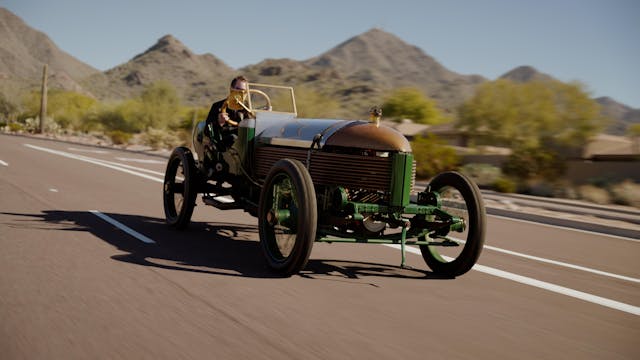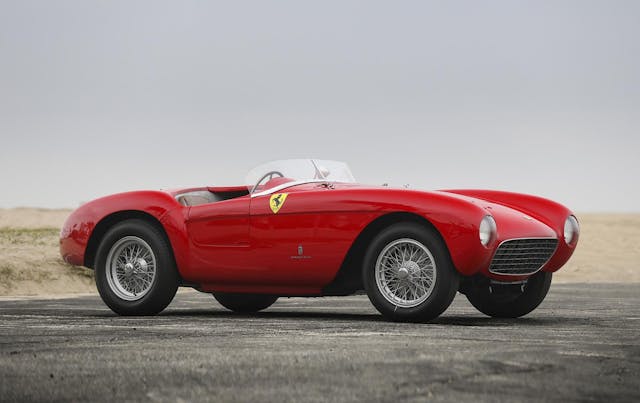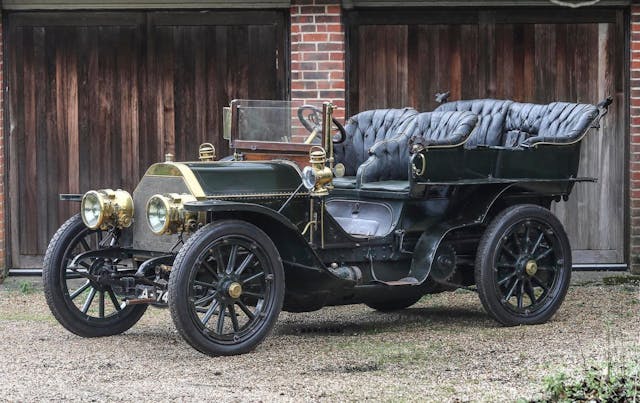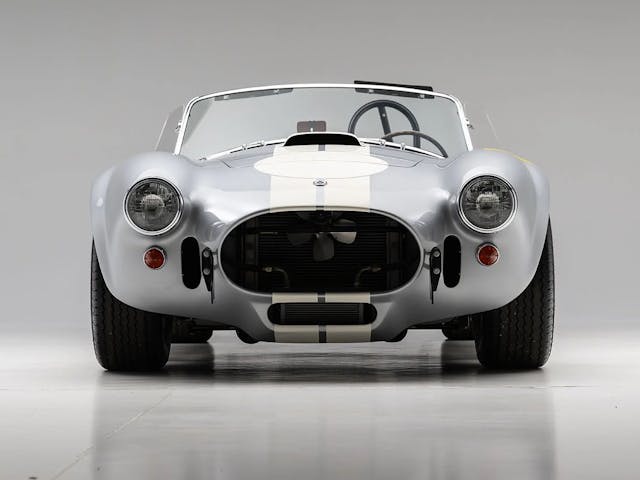These Are the Best Cars up for Grabs at Amelia Island
With the Kissimmee, Scottsdale and Rétromobile auctions behind us, next up on the event calendar is Amelia Island. Three auctions are happening, and we forecast $135M in total sales.
While Kissimmee and Scottsdale are noted for their higher volume, Amelia is a quieter series of sales with consignment lists that are shorter, but also filled with rarer, more significant and higher quality cars, along with a few oddballs thrown in. Between Gooding & Company, Bonhams and Broad Arrow, lots of noteworthy cars are crossing the block this year. Below are the cream of the crop.
1966 Shelby Cobra 427 S/C

In Cobra hierarchy, the big-block cars are naturally at the top. But not all “427” Cobras are created equal, and exact specifications can make a big difference in desirability. They range from cars powered by the higher-volume, road-oriented, police-spec 428 engine at the bottom to the full competition-spec 427 at the top.
This car is one of just 31 “Semi-Competition,” aka “S/C” Cobra 427s. After Shelby failed to secure the 427’s FIA homologation for the 1965 racing season, he was stuck with 31 intended-for-racing finished chassis, which all of a sudden had nowhere to compete. So, he made the pragmatic decision to slap on some basic road equipment and sell them to the public as one of the most outrageous street cars ever made. This one, CSX 3040, impressively retains its original body and drivetrain. It sold in Scottsdale six years ago for $2,947,500 and has a $3M-$3.75M estimate for Amelia.
1988 Porsche 959 SC by Canepa

Any Porsche 959 is special, and the 959s that have been thoroughly upgraded by Canepa in California tend to command a premium price over their factory counterparts. But this 959 also has historical significance, as it was purchased by Nissan, who famously reverse-engineered Porsche’s sophisticated variable all-wheel drive system for its revolutionary Skyline R32 GT-R.
When it went to Canepa for its upgrades in 2019, it only had about 1400 km (less than 1000 miles) on the clock. The transformation, which incudes upgrades that bump the engine to over 800 horsepower, reportedly cost $950,000, and the car has a $3.25M-$3.75M estimate in Amelia. For reference, a stock 1988 959 Komfort has a Hagerty Price Guide value ranging from $900K-$2.6M.
1931 Duesenberg Model J Disappearing Top Convertible Coupe by Murphy

The Model J is certainly in the running for best American car ever made. It’s both magnificent enough and rare enough that it’s noteworthy when any single example comes to market. Even more so when that example hasn’t come to public market or even been seen for decades. According to Gooding & Co., this 1931 Disappearing Top Convertible Coupe is “the very last example known to exist of a sporting body style that had yet to reemerge to the public eye.”
The car passed through several Chicago owners from the 1930s to early 1950s. The first was a relative of the man who founded the Culver Military Academy in Indiana, and a subsequent owner later donated the car to the very same institution in 1959, which is an odd coincidence. The academy made the car available to cadets interested in pursuing mechanical fields, but apparently no aspiring mechanic wrenched on anything too badly, because by the 1960s the Duesenberg was back in private ownership with a family in Chicago. That family placed it in their garage in 1967, and it stayed there until 2022. Brought back to running condition, it has a presale estimate of $2.75M-$3.5M.
1971 Porsche 914/6 GT

Of the roughly 119,000 Porsche 914s built from 1969-76, the vast majority had relatively humble four-cylinder VW power. But Porsche also sold a six-cylinder, 911-powered version called the 914/6 and developed it even further for racing with the 914/6 GT. To make it track- and rally-ready, Porsche added steel fender flares to accommodate wider Fuchs alloy wheels and fitted fiberglass deck lids, rocker panels, and bumpers. Antiroll bars at both ends, 911S ventilated brakes, Plexiglas rear and side windows, an extra front oil cooler, a long-range fuel tank, and competition interior completed the package.
The 914/6 GT was an accomplished car, with class wins at Le Mans and Daytona, the first three places at the Marathon de la Route at the Nürburgring, and the very first IMSA GT Championship. The car up for grabs in Amelia was part of Porsche’s three-car attack on the Monte Carlo Rally in 1971. A clutch failure took it out of the rally, which was eventually won by the little French Alpine A110, but it was later used as Vic Elford’s reconnaissance car for the Targa Florio. It has since been restored to its original Monte Carlo specs. In Amelia, it has a $1.2M-$1.5M estimate, which would put it above the $995,000 Daytona-winning car that sold in 2020 as the world’s most expensive 914.
1904 Gordon Bennet Napier L48

Powered by a 15(!)-liter F-head six-cylinder making 240 hp, this car is reportedly capable is over 100mph. With rear-only mechanical drum brakes and skinny 120-year-old wheels, that sounds terrifying, or exciting, or a little bit of both.
The car is a faithful reconstruction of the 1904 Gordon Bennett Napier L48 “Samson” racer, assembled using the original engine. And quite a power plant it is, represented as the world’s first six-cylinder racing engine. It roared past 100 mph at Daytona Beach in 1905 and set a flying mile record of 104.65 mph. With Dorothy Levitt driving, it also took the Women’s World Speed Record in 1906. It has a $900K-$1.1M estimate in Amelia.
1954 Ferrari 500 Mondial

Though everybody loves the roar of a V-12 Ferrari, the bark of a four-cylinder Ferrari Mondial or Monza took plenty of checkered flags in the 1950s. Designed for Grand Prix racing by Aurelio Lampredi, Ferrari’s first four-banger powered the 500 F2 to World Championships in 1952-53. Later, a detuned version of the alloy four found its way into a sports car called the 500 Mondial (which means “global” in Italian and French). Only a little more than a dozen were built with Pinin Farina bodywork. The battered and burned remnants of a 500 Mondial comprised our controversial “Sale of the Year” pick for 2023.
The car for sale in Amelia is in much, much better shape. Sold new to Dutch racer Herman Roosdorp, it raced at Spa and Zandvoort in period to decent results, including multiple class wins. It came to the U.S. in the 1960s and has been here ever since, hitting the show field at Pebble Beach in 1978 and racing in historic events. In Amelia, it has a $4M-$5M estimate.
1967 Ford GT40 Road Car

The GT40 was a race car first and foremost, but rules dictated that a road going version exist, too. The GT40 crossing the block in Amelia, chassis P/1069, is one of 31 such Mk I GT40s built in road trim.
Assembled alongside its race-ready siblings at Ford Advanced Vehicles in England, it was first painted Opalescent Silver Blue and fitted with Borrani wire wheels and four Weber carburetors for its “Hi-Po” small-block 289 V-8. Ford earmarked it for the Promotion and Disposal Program and planned to ship it to Shelby American for use among the firm’s field managers, but for whatever reason it wound up as a loaner at a Swiss dealership. The dealership’s owner, who also ran the Scuderia Filipinetti racing team, had the car painted and held onto it for the remainder of 1967.
By 1968, though, it was back in England, road registered, and served as a test car in the British car press. After several owners and multiple repaints, it raced in historic events through the 2000s and 2010s, and has finally been refinished back in its Opalescent Silver Blue. GT40s rarely come up for sale and the road-going versions aren’t any different, but Mecum did just sell another Mk I road car in January for $6.93M. The presale estimate for P/1069, meanwhile, is a more conservative but still serious $4M-$5M.
1903 Mercedes-Simplex 60 HP

The likely top sale in Amelia this year is not a late-model Bugatti or an historic Ferrari racer. Nope, it’s a 121-year-old motorcar with no roof, doors or windows, and less horsepower than a new Mitsubishi Mirage. But there are plenty of good reasons why this glorious Mercedes-Simplex has a presale estimate “in excess of $10,000,000.”
Back in the early 1900s, the company known today as Mercedes-Benz Group AG still called itself Daimler Motoren Gesellschaft (DMG). Meanwhile, in the French Riviera, an automobile entrepreneur and Consul General for Autria-Hungary named Emil Jellinek was the company’s official agent for the region. He encouraged DMG to build an all-new motorcar, financed the project, and insisted the new automobile be named after his daughter Mercédès. Designed by Wilhelm Maybach and Paul Daimler, it was called the Mercedes 35 HP. Although the 35 HP was one of the world’s most advanced cars at the turn of the century, DMG developed it further into the Mercedes-Simplex 40 HP and Mercedes-Simplex 60 HP, all of which helped establish the company’s reputation for high performance, excellent build quality, and ease of use.
According to Gooding & Co., the car at Amelia is one of the 102 60 HP models built between 1902 and 1905, and it sold new to British publishing magnate Alfred C.W. Harmsworth. After a few successful competition outings in 1902, Harmsworth had the car bodied in “Roi des Belges” bodywork by Parisian coachbuilder J. Rothschild et Fils. Remarkably, it is one of just five original 60 HP cars known to survive and still has its original chassis, engine and coachwork. Even more remarkably, it has been with the same family since new.



Okay, I’m trying to wrap my head around this 1904 Gordon Bennet Napier L48. It has 6 cylinders with 15 liters of displacement??? That’s 2 and a half liters for each cylinder? how much fuel and air is required to fire just one of those cylinders? Absolutely nuts!
AND – it’s hand-cranked to start! Just turning those 6 big jugs over at all would be impressive, but to do it fast enough to get it sparking and running seems nearly impossible to me. I share your incredulity MeJ!
I long thought how hard to start these engines must have been but after spending time with those who make them their hobby it’s absolutely amazing how easy the process is. With ignition off a couple easy pullovers will prime the cylinders with a purposely rich mixture and they will then bring them carefully up on the compression stroke and with ignition now on , just a partial pull will yield an immediate power stroke and it’s off to the races , on smaller engines if rotated to the correct point in the cycle the engine can often be started just by turning the ignition on , no cranking required. That’s with early spark systems that fired multiple times not we’re not triggered at just a single point in the rotation.
In tune, the Napier L48 will start on only about 15 degrees of turn on the crank. It is relatively low compression. But don’t forget to retard the spark, otherwise it will throw you into the next yard!
Interesting info from Dunbar and Graeme. Makes it sound like one of these is easier to start than my lawn mower! 😛
While cars like the Napier aren’t my thing I still appreciate them. How those early design ‘race’ engines with cylinders the size of gallon paint cans keep chugging along confounds me. When you consider how relatively antiquated their design, metallurgy etc are it’s amazing they ran at all . Then again flash forward 90 yrs. and you’ve got 3 liter F1 V-10s turning 20,000 +. Why those didn’t promptly hand grenade I can’t fathom either. If I had one of these old hand crank cars I’d probably looking to adapt a off car Indy style starter motor or one of the old washing machine units I’ve got squirreled away in the garage. So I guess I’d really woose out and buy the 427 S/C instead. If I’m not mistaken Shelby even installed a cigarette lighter when they were turned to back into road cars. We all become spoiled brats in one way or another.
Cobra, 959 and GT40 for me from this list.
Text wraparound seems to be an ongoing issue. At first I changed from portrait to landscape and issue was resolved. Now words don’t continue on same line on most articles regardless of orientation. Something is not right with the site
Ditto. Still doing it on my Windows laptop, for any article I click on. Then entering this reply I got a notice that I’m “posting too quickly. Slow down.” WTF
I would love to own something as beautiful as the Napier or the Simplex.
Gary, you and I would be in a bidding war…
“Best Cars” What constitutes the best cars…the ones that bring the most money to the auction companies?
I want the Duesenberg!
Only thing I can relate to that type of displacement, believe it or not, is an old John Deere A tractor – we had a ’48 John Deere A on our farm when I was young.. It had a displacement of 309 cu in, which equated to roughly the same cubic inches per cylinder as that ‘beast’.. Engine didn’t rely on high RPM, but the torque would ‘pull stumps’ without much effort..
Hands down the 31 Duesenberg as she has the look and the feel of powerful and rich.
Wait…..let me grab my ATM card!!
Really? Can your feature some cars from an auction some of us might actually afford?
While l also am fascinated with pre-ww1 cars, l agree with Joe that perhaps a Part Two article with “affordable” (under 30-40K?) would spark (crank?) some further passion in more of us.
I have been infatuated with Deunenburgs since I was a teenager. Early Motor Trend magazine typically had an article on the Classics. That was my introduction to Dueses. In 1976 (I think), I attended Harrah’s the week before it transitioned to ownership by the hotel/motel chain. Yes, I saw a couple of Deunenburgs. And bought a ceramic replica of an open bodied boattail. Did I mention that it is filled with Jim Beam – the seal unbroken?